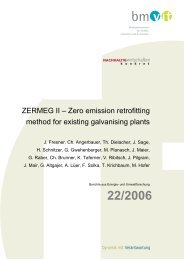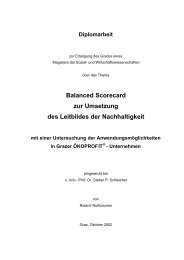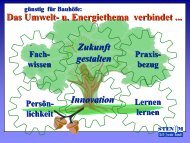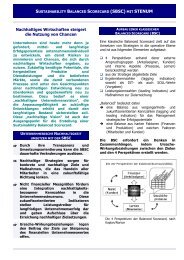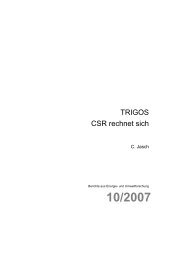Promoting Resource Efficiency in Small & Medium size ... - UNEP
Promoting Resource Efficiency in Small & Medium size ... - UNEP
Promoting Resource Efficiency in Small & Medium size ... - UNEP
Create successful ePaper yourself
Turn your PDF publications into a flip-book with our unique Google optimized e-Paper software.
• 22°C reduction <strong>in</strong> flue gas temperature <strong>in</strong>creases boiler<br />
efficiency by 1%<br />
• 6°C rise <strong>in</strong> feed water temperature brought about by economiser/<br />
condensate recovery corresponds to a 1% sav<strong>in</strong>g <strong>in</strong> boiler fuel<br />
consumption.<br />
• 20°C <strong>in</strong>crease <strong>in</strong> combustion air temperature, pre-heated by<br />
waste heat recovery, results <strong>in</strong> a 1% fuel sav<strong>in</strong>g.<br />
• A 3 mm diameter hole <strong>in</strong> a pipe carry<strong>in</strong>g 7 kg/cm 2 steam would<br />
waste 2,650 litres of fuel oil per year<br />
• 100 m of bare steam pipe with a diameter of 150 mm carry<strong>in</strong>g<br />
saturated steam at 8 kg/cm 2 would waste 25,000 litres furnace<br />
oil <strong>in</strong> a year<br />
• 70% of heat losses can be reduced by float<strong>in</strong>g a layer of 45 mm<br />
diameter polypropylene (plastic) balls on the surface of a 90°C<br />
hot liquid/condensate<br />
• A 0.25 mm thick air film offers the same resistance to heat<br />
transfer as a 330 mm thick copper wall<br />
• A 3 mm thick soot deposit on a heat transfer surface can cause<br />
a 2.5% <strong>in</strong>crease <strong>in</strong> fuel consumption<br />
• A 1 mm thick scale deposit on the <strong>in</strong>side could <strong>in</strong>crease fuel<br />
consumption by 5 to 8%<br />
Electrical energy<br />
Compressed air<br />
• Every 5°C reduction <strong>in</strong> <strong>in</strong>take air temperature would result <strong>in</strong> a<br />
1% reduction <strong>in</strong> compressor power consumption<br />
• Compressed air leak<strong>in</strong>g from a 1 mm hole at a pressure of 7 kg/<br />
cm2 means power loss equivalent to 0.5 kW<br />
• A reduction of 1 kg/cm 2 <strong>in</strong> air pressure (8 kg/cm 2 to 7 kg/cm 2 )<br />
would result <strong>in</strong> a 9% sav<strong>in</strong>g <strong>in</strong> <strong>in</strong>put power<br />
• A reduction of 1 kg/cm 2 <strong>in</strong> l<strong>in</strong>e pressure (7 kg/cm 2 to 6 kg/cm 2 )<br />
can reduce the quantity leak<strong>in</strong>g from a 1 mm hole by 10%<br />
Refrigeration<br />
• Refrigeration capacity reduces by 6% for every 3.5°C <strong>in</strong>crease<br />
<strong>in</strong> condens<strong>in</strong>g temperature<br />
• Reduc<strong>in</strong>g condens<strong>in</strong>g temperature by 5.5°C results <strong>in</strong> a 20 –<br />
25% decrease <strong>in</strong> compressor power consumption<br />
• A reduction of 0.55°C <strong>in</strong> cool<strong>in</strong>g water temperature at condenser<br />
<strong>in</strong>let reduces compressor power consumption by 3%<br />
• 1 mm scale build-up on condenser tubes can <strong>in</strong>crease energy<br />
consumption by 40%<br />
• A 5.5°C <strong>in</strong>crease <strong>in</strong> evaporator temperature reduces compressor<br />
power consumption by 20 – 25%<br />
Electric motors<br />
• High efficiency motors are 4 – 5% more efficient than standard<br />
motors<br />
• Every 10 °C <strong>in</strong>crease <strong>in</strong> motor operat<strong>in</strong>g temperature beyond the<br />
recommended peak is estimated to halve the motor‘s life<br />
• If rew<strong>in</strong>d<strong>in</strong>g is not done properly, efficiency can be reduced by<br />
5 – 8%<br />
• Balanced voltage can reduce motor <strong>in</strong>put power by 3 – 5%<br />
• Variable speed drives can reduce <strong>in</strong>put energy consumption by<br />
5 – 15%; as much as 35% of energy can be saved for some<br />
pump/fan applications<br />
• Soft starters/energy savers help to reduce power consumption<br />
by 3 – 7% of operat<strong>in</strong>g kW<br />
Light<strong>in</strong>g<br />
• Replacement of <strong>in</strong>candescent bulbs with CFL’s offers 75 – 80%<br />
energy sav<strong>in</strong>gs<br />
• Replacement of conventional tube lights with new energyefficient<br />
tube lights with electronic ballast helps reduce power<br />
consumption by 40 – 50%<br />
• 10% <strong>in</strong>crease <strong>in</strong> supply voltage will reduce bulb life by one-third<br />
• 10% <strong>in</strong>crease <strong>in</strong> supply voltage will <strong>in</strong>crease light<strong>in</strong>g power<br />
consumption by an equivalent 10%<br />
Build<strong>in</strong>gs<br />
• An <strong>in</strong>crease <strong>in</strong> room temperature of 10°C can <strong>in</strong>crease the<br />
heat<strong>in</strong>g fuel consumption by 6 – 10%<br />
• Install<strong>in</strong>g automatic light<strong>in</strong>g controls (timers, daylight or<br />
occupancy sensors) saves 10 – 25% of energy.<br />
• Switch<strong>in</strong>g off 1 tonne w<strong>in</strong>dow A/C for 1 hour daily dur<strong>in</strong>g lunch<br />
hour avoids consumption of 445 kWh.<br />
5.4 CHECKLIST: Energy sav<strong>in</strong>g<br />
5.4.1 Domestic<br />
Laundry<br />
• Use lower temperature sett<strong>in</strong>gs; use warm or cold water for the<br />
wash cycle <strong>in</strong>stead of hot (except for greasy sta<strong>in</strong>s) and only<br />
use cold for r<strong>in</strong>ses. Experiment with different laundry detergents<br />
to f<strong>in</strong>d one that works well with cooler water. By pre-soak<strong>in</strong>g<br />
heavily soiled clothes, a cooler wash temperature may be f<strong>in</strong>e.<br />
The temperature of the r<strong>in</strong>se water does not affect clean<strong>in</strong>g, so<br />
always set the wash<strong>in</strong>g mach<strong>in</strong>e on cold water r<strong>in</strong>se.<br />
• Load the wash<strong>in</strong>g mach<strong>in</strong>e to full capacity when possible. Most<br />
people tend to under load rather than overload their washers.<br />
Check your mach<strong>in</strong>e’s load capacity <strong>in</strong> pounds or Kg, then<br />
weigh out a few loads of laundry to get a sense of how much<br />
laundry 10 or 18 to 20 pounds or Kg represent to enable you<br />
to judge the volume of clothes for a load. Wash<strong>in</strong>g one large<br />
load will take less energy than wash<strong>in</strong>g two loads on a low or<br />
medium sett<strong>in</strong>g.<br />
• Air or sun dry clothes on the l<strong>in</strong>e whenever possible.<br />
• When us<strong>in</strong>g a dry<strong>in</strong>g mach<strong>in</strong>e, separate your clothes and dry<br />
similar types of clothes together. Lightweight synthetics, for<br />
example, dry much more quickly than bath towels and natural<br />
fibre clothes.<br />
• Do not over dry clothes. Take clothes out while they are still<br />
slightly damp to reduce the need for iron<strong>in</strong>g - another big<br />
energy user. If your dryer has a sett<strong>in</strong>g for auto-dry, be sure to<br />
use it <strong>in</strong>stead of the timer to avoid wast<strong>in</strong>g energy.<br />
• Clean the dryer filter after each use; a clogged filter will restrict<br />
flow and reduce dryer performance.<br />
• Dry full loads when possible as dry<strong>in</strong>g small loads wastes<br />
energy. However, be careful not to overfill the dryer so that air<br />
can circulate freely around the dry<strong>in</strong>g clothes.<br />
Canteen<br />
• Methods of cook<strong>in</strong>g that m<strong>in</strong>imise the area that must be heated<br />
(a toaster oven versus an oven, for example) saves energy. On<br />
the other hand, sometimes the most efficient cook<strong>in</strong>g methods<br />
such as a microwave can sacrifice food quality. The trick is to<br />
f<strong>in</strong>d the right balance, or an appliance explicitly designed for a<br />
particular type of meal (crockpot, rice-cooker, etc.)<br />
• Match the pan <strong>size</strong> to the element <strong>size</strong>; for example, when us<strong>in</strong>g<br />
an electric stovetop (hob), a 6” pan on an 8” burner will waste<br />
over 40% of the heat produced by the burner<br />
• Buy sturdy, flat-bottomed cookware<br />
• The ideal pan has a slightly concave bottom — when it heats<br />
up, the metal expands and the bottom flattens out. An electric<br />
element is significantly less efficient if the pan does not have<br />
good contact with the element. For example, boil<strong>in</strong>g water for<br />
pasta could use 50% more energy on a cheap, warped-bottom<br />
pan compared to a flat-bottom pan.<br />
• Use high-conductivity materials<br />
50





